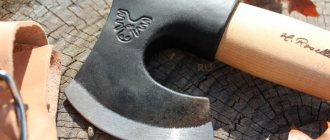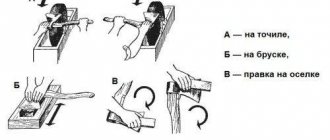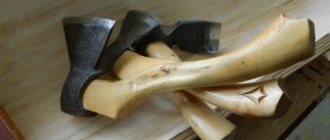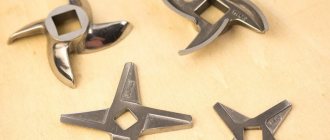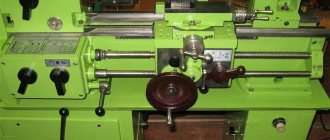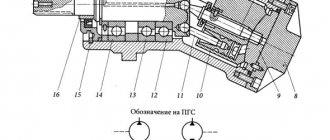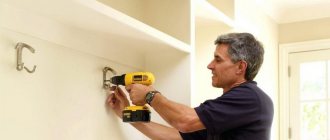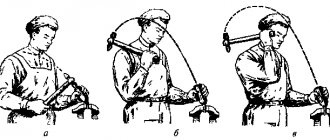Correct tool sharpening technology
The technology for sharpening a professional meat ax is practically no different from a similar procedure for other piercing and cutting tools (Figure 5).
To carry out the procedure correctly, you must consider the following:
- The work area must be properly equipped. The sharpening tool must be firmly installed on the bed, and the bed must be attached to the floor so that it does not move during operation.
- Before starting work, carefully inspect the abrasive wheel: it must be absolutely smooth, without beating or nicks. Only in this case will you be able to sharpen it technologically correctly and without harm to the blade.
- Take care of personal protective equipment as well. First of all, you need to put on safety glasses. Kitchen hatchets are made of high-quality steel, and during the sharpening process, metal splashes and abrasive dust can fly in all directions and accidentally get into your eyes.
- The sharpening technology itself is as follows: the blade is held in the direction “away from you” towards the rotation of the circle and parallel to its axis. It is advisable to hold the ax with both hands so that you can accurately maintain the sharpening angle.
- During the process, try not to overheat the cutting edge. As a result, the steel of the blade may become too brittle and will crumble during further use.
Figure 5. Correct sharpening technology
If during sharpening you notice that a burr has accidentally formed on the blade, do not despair. This does not mean that the instrument is damaged. To correct the situation, simply turn the ax over and start sharpening it in the other direction. It is better to bring the cutting edge to the desired condition on a small abrasive wheel
At this stage, extreme care must be taken so that the edge of the chip does not break off, and the edge itself remains strong. To do this, it is best to use the double sharpening method.
At the final stage, you can check the sharpening angle of the blade using special templates and, if necessary, bring the product to perfection.
Advantages and disadvantages
A kitchen hatchet makes cutting up carcasses much easier and helps save time. Thanks to special hardening, it can be used for a long period without additional sharpening. Other advantages of the ax:
- made of durable steel;
- capable of cutting even the hardest parts of a carcass with bones and cartilage;
- maintenance does not require large expenses;
- versatility - can even be used instead of a meat grinder.
The biggest disadvantages of the product are its considerable weight and the need to use physical force to operate. The wooden handle of an ax may deteriorate over time. To prevent this, it is important to follow the recommended storage conditions and properly handle the instrument.
In all cases, the ax must be equipped with a blade guard. This is the main safety rule, because when using it there is a risk of getting hurt on the sharp edge.
Manual sharpening option
There are also quite a lot of tools for manually sharpening an ax blade. Their advantage is that you do not have to spend a lot of money to purchase the necessary device, and its small dimensions will allow you to store it in any kitchen drawer. The downside is the length of the sharpening procedure itself, especially if you are working with a meat cleaver with a large blade (Figure 7).
To cut meat in one motion, use the following hand sharpening tools:
- Musat:
as a rule, this tool is used for final straightening of the blade, and not for its direct sharpening. Externally, the musat is a long file rod with notches and an abrasive coating. Despite its limited functionality, it is still worth including the grinder in your arsenal of kitchen utensils, as it will help correct a burr on the blade or make it sharper in just a few movements. - Whetstone or Stone:
This is a more serious sharpening tool that is used to directly improve the sharpness of the blade of a kitchen ax or knife. If you want a truly sharp axe, it is better to buy several stones coated with different degrees of grain. - Special sharpening kits:
an ideal option for those who want to sharpen not only kitchen hatchets, but also knives, without going into the details of working with a whetstone or machine. As a rule, such sets include several stones coated with varying degrees of grain, a special fixing stand and additional accessories.
Figure 7. Tools for manual sharpening: sharpening sets, grinding stone and whetstone
If you are not a professional butcher and use an ax infrequently and exclusively at home, hand sharpening tools are ideal for you. But for those who, as part of their profession, often work with frozen meat or hard bones, it is better to give preference to sharpening the ax blade on special electrical appliances.
What determines the method of sharpening an ax?
Proper sharpening of an ax
“I sharpened my ax with firebrands and the yard is full of firebrands” - this is the statement that speaks best about the importance of properly sharpening this device. The method of sharpening an ax is determined by the following factors:
The method of sharpening an ax is determined by the following factors:
- The density and hardness of the wood that is planned to be processed.
- The quality and condition of the processed material. An abundance of knots, twisted and dense wood requires a sharper cutting edge.
- Wood moisture level. Dry wood is tougher and puts more stress on the cutting edge of the tool, while wet wood is soft and does not dull the blade too much.
- Specifics of the work performed. Cutting wood in the transverse direction uses up the cutting edge more than trimming it tangentially.
- Metal grade. The harder the steel, the more difficult it is to sharpen, but the longer the serviceability of the cutting edge.
Of all the above factors, the main one is the grade of the metal, since the ability of the steel to hold an edge, withstand work loads and not break, forming nicks and gouges on the blade, depends on it.
How to sharpen an ax using an electric sharpener
An electric sharpener is a machine with an electric drive. Its main working body is the abrasive wheel. The surface used is the generatrix of a cylinder, which eliminates lateral movement of the tool being sharpened.
In addition to the sharpening machine itself, you will also need:
- double-sided hand sharpener;
- polishing paste;
- marker;
- protective equipment: glasses, gloves, thick overalls and shoes;
- goniometer device
Before you start sharpening, you should put on glasses and gloves. Next perform the following operations:
- Paint over the existing chamfer with a marker.
- Secure the ax in the machine's mounting fixture.
- Bring the tip to the grinding wheel.
- Set the sharpening angle using a protractor and an adjusting nut.
- Turn the grinding wheel by hand.
- Check the bevel - if the angle is set correctly, the ink will be completely erased at the point of contact with the stone.
- Adjust the angle as necessary.
- Only now should you TURN ON the sharpener.
- Sharpen the chamfer until all nicks and nicks are leveled.
- Level the working surface of the abrasive with a hand sharpener.
- Bring the sharpening to perfect condition.
- Remove the tool from its mounts, lubricate a leather or felt wheel with polishing paste and polish the bevels of the tip.
- Apply anti-corrosion fluid.
Sharpening an ax with an electric sharpener
During operation, be sure to periodically moisten the surface of the abrasive with water or oil. The blade also needs to be wetted regularly. This will help avoid overheating of the metal and unwanted changes in its structure, leading to a decrease in strength and other performance qualities.
If you need to change the sharpening bevel, you should skip the operations with a marker and manually turning the disk and immediately set the angle using the protractor.
An electric sharpening machine allows even the least experienced sharpener to achieve ideal angles and bevel widths. However, high-quality equipment is not so cheap. It will give an economic effect when there is a large number of sharpened tools and the frequent need for sharpening them.
Tips for use and care
In order for a tool to serve for many years, it needs to be properly cared for and stored properly. Recommendations to follow:
It is better to store axes for chopping meat in a separate box, away from all other tools. If it is convenient for the housewife to keep the product at hand, on an open kitchen surface, ideally she will need a special stand for this.
You can store the ax in a case made of thick leather, or in a suspended state if there is a recess or hook on the handle - this will save space in the kitchen and extend the life of the product. It is important to remember that the worst enemy of metal and wood is a damp environment. A prerequisite for storing the instrument is a dry and warm room. The hatchet will serve for a long time if you use it exclusively for its intended purpose, and immediately after use, rinse it well with a special product and wipe it dry with a towel.
For cleaning, it is permissible to use a dishwasher. Work should be done on a cutting board. You can use a wooden or plastic variation; glass models quickly dull the hatchet. The blade of a meat cleaver stays sharp for a long time, but sooner or later it will still need to be sharpened. For this purpose, it is better to contact professionals who specialize in servicing such products. Be sure to periodically wipe the metal parts of the product with kerosene, and lubricate the blade itself with vegetable oil to protect the material from premature destruction. When using an ax, you must ensure that the blow is completed in one approach, otherwise there is a risk of crushing the bones into small pieces. This will negatively affect the quality of the cut meat and its subsequent preparation. If the handle is made of wood, you can purchase special protection for it in the form of a spray. Treatment is required if the product is to be stored for long-term storage.
The most important thing is not to forget about safety precautions when working with a tool; you should not use an ax whose structural integrity is in doubt.
You need to chop with an ax on a cutting board
Be sure to sharpen on time
If the handle is made of wood, it must be treated with a special spray
Features and purpose
A classic ax for chopping meat consists of an extended blade and a medium-length handle. It is sharpened to quickly and accurately cut meat and chop bones. The weight of such a device is approximately 3 kilograms. The tool differs from the usual household ax in its shape and material of manufacture. It is not so massive, making the product easier to work with. Due to the special configuration, the tool does not slip during operation; the center of gravity is located just between the butt and the tip, which allows for more accurate blows. This cleaver is used for chopping any type of meat, including frozen meat. The tool easily copes with cartilage and bones, and is also suitable for cutting fish.
Kitchen models have a one-piece design, while ordinary household tools consist of a handle and a blade.
Sharpening angle
You also need to choose the optimal sharpening angle. For a construction ax it is 25-30°; carpentry tools are sharpened at 35°. The cleavers are sharpened at 40°. In this matter, the main importance is not so much the angle itself as the shape of the cutting edge. There are three types:
Figure 3 – Ax sharpening angle
- Straight. The chamfer is flat, uniform along the entire length of the blade.
- Convex. The chamfers stick out slightly.
- Concave. The chamfers are sunken, similar to a straight razor blade.
Straight chamfer is a universal option, suitable for any type of work. A convex chamfer is made when working with material of heterogeneous density, which greatly consumes the tool blade. A concave chamfer allows you to hold an edge for a long time, but is only suitable for more delicate, precise and neat work.
Characteristics of a meat ax
Its main difference is its wide blade and curved handle. They sharpen mainly on one side. Double-sided sharpening is a rarity. Options:
- blade length – 13.5 – 18 cm;
- handle length – up to 30 cm;
- It is based on alloy steel (it is durable and resistant to corrosion).
A convex cutting edge can:
- split the bones;
- penetrate the pulp without difficulty.
The curved shape of the handle with a thickening at the tip prevents injury to the hand. Hardwoods are the best materials for handles. The strength of the blade depends on its special hardening. It chops thick bones without splinters. Also suitable:
- frozen meat;
- fish.
You can make a hatchet with your own hands.
Standard errors
There are several common mistakes when sharpening:
- Overheating of the material when working on an electric grinder. This leads to a change in the internal structure of the steel and, as a consequence, to a loss of strength and elasticity. At the same time, the wear resistance, sharpness and other performance qualities of the tool are significantly reduced. To avoid overheating, you need to periodically moisten the abrasive with water or other coolant.
- An attempt to sharpen an ax on a grinder. When holding the grinder in your hand, beating cannot be avoided, and the blade will constantly move to the side. In such conditions it is impossible to talk about observing any angles. Here it would be nice to just hold in your hands a dangerous tool that is flying to the sides. Attaching an angle grinder to the machine will improve the process, but not much. The problem of lateral slip will not go away.
- The desire to sharpen a blade on old equipment with a worn-out sharpening wheel. Axial runout and unevenness of the abrasive surface will not allow you to sharpen the ax efficiently, in compliance with the required angles and width of the chamfers.
It is better to spend more time sharpening the tool by hand than to use low-quality or unsuitable equipment.
Making an ax with your own hands
If you are interested in the question of how to make an ax, then remember that you will not be able to make a blade from scratch yourself. You can only give a regular blade the desired shape by processing it with a grinder or an emery wheel.
But it’s quite possible to make an ax handle. To do this you need:
- select a workpiece with a diameter of more than 120 mm and a length 200 mm longer than the planned handle;
- dry for several months at a temperature of 22-24 degrees and a humidity of 15%;
- using an ax or large knife, remove excess wood in accordance with the outlined contour;
- carry out processing with a chisel and hammer.
Now it is important to learn how to mount an ax correctly. This is done using gauze and epoxy resin.
The presence of a wedge provides better strength. After this, grinding is done, and the ax handle is varnished. Sharpening is done on a machine or manually.
An ax is a useful assistant both in the country and on a hike and when working in the forest. You just need to choose the right model, focusing on the required characteristics and workmanship of a particular instance.
How to make an ax for chopping meat with your own hands: collecting materials
In order to make an ax for chopping meat with your own hands, you need to prepare tools and materials:
- high-carbon steel of excellent quality - you can use tool steel or blanks from old car springs;
- a welding machine is desirable, but you can do without it;
- wooden board – it will be convenient to make blanks on it;
- “grinder” and several cutting and grinding discs;
- parts for making pins - brass rods, copper tubes;
- construction marker, drill;
- jigsaw and hammer;
- sandpaper of different grain sizes;
- vices and files;
- fire bricks, gas burner and metal tempering oil;
- clamps;
- varnish for finishing the handle.
Watch the video on how to make a hatchet from a spring with your own hands:
The process of sharpening an ax
Sharpening an ax properly requires attention and concentration. You will need:
You will need:
- a set of abrasive stones with different grains;
- a piece of rough cloth;
- measuring stick or protractor;
- water;
- The belt is usually made of genuine leather.
First you need to measure the current sharpening angle. This is done by applying a measuring block. The block is made with a bevel equal to the angle at which you decide to sharpen the tool.
to sharpen an ax, place it on a flat base (table, stool) and begin to draw a block along the blade, describing half rings. The block should be held at a sharpening angle. Coarse abrasive is used to restore the required slope and width of the chamfer. The operation is repeated on the other side of the blade.
Next, you should take a block with a medium grain and sharpen it on both sides. And finally, it’s the turn of the third, smoothest sharpener - it is used to remove burrs and the smallest irregularities. The surface of the chamfer should be smooth to the touch.
The testamentary operation is editing on a tense leather belt.
During work, the ax and abrasive bars must be moistened with water. Dust and small metal particles are removed with a piece of cloth.
During initial sharpening and in cases where the ax has become very dull, experts recommend removing it from the ax handle. And the tilt will be easier to maintain, and the handle will not get in the way.
Professionals use special sharpening devices - electric sharpening machines. There are adjustable stops for the sharpened tool, allowing you to sharpen it at a given angle.
Proper sharpening at home
Figure 5 – Proper sharpening at home
The sharpening technique largely depends on the type of abrasive used to chamfer and form the cutting edge.
Working techniques on different tools differ radically from each other, depending on the method of removing the metal layer.
The choice of the optimal option is usually determined by the following factors:
- Availability of one or another tool.
- Possession of skills and experience in sharpening using this method.
Each method of sharpening has its admirers who give strong arguments in favor of one method or another, however, it is impossible to name the ideal option. All technologies demonstrate their own pros and cons, so you should consider them more carefully:
On the grinding machine
Figure 4 – Sharpening an ax on a grinding machine
Sharpening an ax on a sharpener is much easier than by hand.
The ax is held with the cutting edge facing the rotation, the central plane running tangent to the rotating abrasive wheel.
With even a little skill, it is not difficult to form an even chamfer and grind off a neat and uniform working edge.
However, there are also negative aspects of working on an electric grinder.
A major issue is continuity of exposure. Friction causes the metal to become very hot, which creates the threat of overheating and changes in the crystal lattice of the material. It is necessary to keep a container of cold water on hand, into which you must constantly dip the ax to cool. This distracts from the sharpening process, but helps prevent overheating.
While working, you must constantly check the template, check the angle and other chamfer parameters. Most often, they first do preliminary sharpening on both sides, after which they bring one of them until a continuous burr appears along the entire length of the blade, turn the ax over and sharpen the second chamfer until the burr breaks off. The edge is then finished by hand using an abrasive stone.
Special devices have been developed to hold the ax in a stationary state and help to obtain a uniform, even chamfer with a constant angle. However, they can only be used for axes with a straight cutting edge, so they often work while holding the tool in their hands.
On sandpaper or with a block by hand
This method takes a lot of time and requires skill. However, experienced craftsmen claim that this is the only way to get a non-overheated and even working edge and sharpen it correctly. A block or waterproof sandpaper is used as an abrasive. The surface is moistened with water, the ax is applied at the desired angle and in a circular motion, with medium pressure, sharpened until the expected result is obtained. The process is lengthy and labor-intensive, as well as tedious. But the main danger of overheating the blade is absent, and there is also no threat of awkward movements to ruin the edge or change the sharpening angle.
Often the work is speeded up with the help of a file. Pre-grind the blade with coarse sandpaper to remove burrs and other large irregularities. Then the ax is fixed in a comfortable position, a bastard file is taken and an edge is formed on both sides. During this, you need to periodically check the form using the template. When the edge is finally formed, the ax is brought to the desired state on an abrasive wheel (bar) by hand.
Bulgarian
It is not recommended to use a grinder to sharpen an ax. The rotation speed of the disk is too high, which creates the danger of instant overheating of the ax, the appearance of depressions and irregularities on the working edge. If the angle grinder is secured and used as an electric sharpener, there is a serious risk of injury with an unpredictable outcome. Occasionally, an angle grinder (angle grinder) is used for sharpening, but this option cannot be called optimal due to the danger of overheating and the impossibility of fully monitoring the condition of the edge and maintaining the desired angle of inclination.
Using a sharpener for straightening cutting devices
An electric sharpener is used to sharpen various tools used in carpentry work: chisels, chisels, etc. To make the cutting edge sharp, use a special fine-grained stone and a low-speed sharpener.
When working with metal structures, where a lot of drilling is required, there is a constant need to sharpen metal drills. In this case, the master needs to know at what angle the drill is tucked. Each material has its own hardness. Approximate values of sharpening angles for various types of materials are given below.
To properly sharpen a drill, various devices are used to hold it at a certain angle to the abrasive wheel. What such devices look like is shown in the photo below.
It would seem that the simplest operation is to sharpen an ax. It is difficult to overheat, since it has a significant mass of metal. But even here difficulties may arise.
- For each operation performed with an ax, a certain sharpening angle is required. So, for working with fresh raw wood it is 20 degrees, and for trimming dry firewood - 30 degrees.
- Sharpening an ax on an electric sharpener overheats the metal of the blade, which leads to increased fragility. When working, such an ax will very quickly become dull again.
- You should sharpen the ax at low speeds and eliminate the beating of the abrasive as much as possible.
- Use a water-cooled electric sharpener or constantly immerse the ax in cold water.
- You need to sharpen the ax by holding its blade towards the rotation of the abrasive disc. The butt should be located at an angle of 45 degrees relative to the circle.
When working with an electric sharpener, you should follow safety precautions. Do not use the sharpener without protective covers: the abrasive wheel may fly apart and cause injury during operation. It is also necessary to use eye protection against scale and sand.
Ax chamfer width
The width of the chamfer corresponds to the distance from the axis of the blade to its side surface. This parameter determines both the sharpness of the tool and the service time until the next sharpening. Sharpening an ax with the correct bevel is quite quick and easy.
Correcting the dimensions of the chamfers is a more complex operation and will require a lot of time and effort. To change the width of the chamfers, it is necessary to remove excess metal.
Historically, axes damaged by long work or corrosion, which had lost part of the metal in the chamfer area, were restored by a blacksmith using the method of partial reforging. The weight and dimensions became smaller, but the geometric parameters and functionality of the instrument were restored; it was enough to sharpen it again.
Double beveled ax
Axes made from low quality metal wear out quickly and lose their bevel shape. In this case, you should sharpen the tool asymmetrically: - one chamfer is made at 15°, and the other at 25°.
Recommendations for selection
According to experts, when choosing an ax for cutting meat, you should take into account some nuances
Blade Specifications
This detail is the most important in the entire design; a good blade will be thick and weighty. It is precisely these properties of the metal element that determine the classification of this device into the category of hatchets, since it is the balance between the mass and thickness of the metal that will be responsible for the chopping capabilities of the tool
As for the shape, it can be straight or rounded.
Product handle configuration
The optimal size of the handle will be the ability to operate the tool with one hand, that is, its length should be within the palm of your hand. In addition, it is best that it has a rounded shape with special recesses for a comfortable location of all fingers. This way the tool will not slip out while cutting meat.
Cutting edge type
The classic sharpening option is not suitable for an axe, since it is important that the edge remains sharp in working condition on each side. This feature will greatly facilitate the further operation and maintenance of the ax due to the fact that this type of product is the easiest to sharpen by choosing the correct sharpening angle
The optimal angle would be 40 degrees. This product will allow the tool to cut fibers and bones as deeply as possible.
Type of steel used
As a rule, certified products, unlike products made by handicraft, will have a special mark on the head of the tool. Such an abbreviation will contain data about the grade of steel used to produce the ax.
It is important to pay attention to the fact that it should be in the area where the handle comes into contact with the cutting part
Additional configuration details
Good and high-quality products should have a special eyelet on the body, which will allow you to properly store the equipment after use.
Place of purchase and cost
Often the cost of the same product will differ significantly when comparing the pricing policies of supermarkets and markets. Therefore, you can safely purchase kitchen tools at retail outlets, which will save money, however, this will not in any way affect the quality of the purchased product. Also, for rare use of an ax, buying an expensive tool is simply pointless. Today, inventory from domestic and foreign brands is on sale, which, for the most part, have high quality indicators for the products sold.
Ease of use
It is best to select kitchen or professional tools yourself. Before purchasing, you should definitely test the cleaver, hold it in your hands, evaluate the comfort of the handle, weight and other characteristics of the product you like. Otherwise, there is a risk that even a high-quality and attractive tool will simply be unsuitable for a cook, butcher or housewife.
How to choose a quality hatchet for chopping meat
A hatchet for chopping meat should be chosen not only by price and manufacturer, although these are also important indicators. Since it is expected to work quite hard with it, you should pay attention to some other facts.
Blade rating
The blade shape can be straight or rounded, and this characteristic does not affect the functionality of the tool. It is important to determine the ratio of the thickness and weight of the hatchet - these parameters should be maximum. Only in this case can you count on the cutting properties of the hatchet.
It is not at all necessary to have a sharp sharpening of the cutting edge, it all depends on the type of butcher's ax - a professional one will have a high sharpness, a kitchen one allows for a slight reduction in the parameter.
Handle configuration
They use the hatchet with one hand, so the length of the handle should be within the palm of your hand. The shape of this part of the kitchen tool should be somewhat convex - this will ensure comfort when held in the palm of your hand for a long time.
It is imperative to make sure that there are several notches on the handle of the tool - this is a guarantee of safety when chopping meat/fish, because the palm will not slip and be injured.
Steel
If the kitchen tool is made in production, and not by “Kulibins”, then there will definitely be a mark on the head of the blade. It contains all the information about what steel was used in manufacturing.
Most often the following brands are used:
- U7A;
- U8;
- U8A;
- U8GA.
It is worth purchasing a forged ax, and to ensure the quality of the product, you need to lightly click the blade with your nails or perform a light chopping movement in contact with any hard surface - the sound should come out clear .
Center of gravity
This indicator is important from the point of view of ease of use of the tool. According to the rules, the center of gravity should be located on the handle, but as close as possible to the blade. Only in this case will it be possible to expend less physical effort when chopping - the hatchet “itself” will cut the flesh and chop the bones.
Ease of use
It is not recommended to give a meat ax as a gift, even if a person really needs it and the product has high quality characteristics. The fact is that such tools are selected individually - the potential owner must hold it in his hand for several minutes, perform 2-4 swinging/chopping movements and evaluate the following parameters:
- comfort of the handle;
- product weight;
- center of gravity;
- handle dimensions;
- the presence of grooves for fingers and so on.
Watch the video about a convenient version of an ax for chopping meat:
Characteristics
The functions of a kitchen meat hatchet are inherent in the very name of the tool. The product does not cut, but rather chops without destroying the connective fibers of the fabric - this is facilitated by the width of the blade and increased weight. The balanced shape and minimal thickness of the metal prevent bones from crumbling and cracks from forming. In operation, such axes are much more ergonomic than knives, which can also be used to chop meat, with some effort. The efficiency of the product is high, and the user’s hand does not get tired.
Material
To create a butcher's hatchet, metal is used that is resistant to corrosion and scratches. Companies often produce tools from alloy steel grades X12MF, AUS-8, VG-10, which are best suited for this purpose. The advantage of this material is its long service life. If nicks and scratches appear on the blade, it becomes more difficult to work with - in this case, immediate grinding and sharpening is required.
Blade size and shape
A meat cleaver can have different shapes, so the choice of the right type will depend on the purpose of use. To work without extra effort, you should give preference to a product with a very wide blade and a slightly convex shape of the cutting side. This will make the process of splitting bones much easier. The described shape allows the ax to penetrate the meat at an acute angle. The blade is usually made elongated so that a larger area of the carcass is captured. The optimal blade size in a kitchen hatchet for chopping meat is considered to be 135-180 mm.
Sharpening
The sharpening angle of the tool is of great importance. It is desirable that it be within 25-30 degrees. The sharpening should not be an even cone, but rather have a slightly rounded shape, with a slight acute angle. This will make it easier for the metal to penetrate the product - even with a slightly dull blade, the bones will break without problems and the meat will be cut quickly.
You can make the blade sharp yourself. One of the important aspects of such work is a correctly formed chamfer. The process is carried out in several stages. The best material for this purpose is a ceramic musat (has some similarities with a file), which is a rod with a handle with an oval or round cross-section. For sharpening, you can use a diamond stone or a sharpening wheel.
Varieties
Cleavers are classified by blade width. When choosing between them, it is important to decide for what purpose the product is being purchased: for cutting livestock carcasses on the farm, professional work, small tasks in the kitchen or country house. Particular attention is also paid to the working part, and the weight of the tool is taken into account. In any case, the physical capabilities of the user are also important.
Professional cleavers
The average blade width of a professional hatchet for chopping meat and bones is 23-25 cm. It is made by forging from an all-metal template, which eliminates mechanical damage of any kind. Due to the strength and hardness of spring steel, such axes can withstand heavy loads and have a long service life. The holder is made mainly of wood. Professional axes are designed mainly for chopping meat products of different densities, while maintaining the integrity of the processed raw materials.
With medium blade width
This model is close to a professional cleaver. The width of the blade here is smaller, approximately 17-20 cm. The ax does an excellent job of cutting up carcasses and can be used to separate bones from meat. Some housewives use it instead of a meat grinder. The 20 cm ax is especially convenient for use on a small farm.
With small cutting element
Recommended for simple cutting of carcasses. It's more like a kitchen meat hatchet that won't cope with the task of chopping. Can be useful in everyday life, does not require special skills in this area. The blade width here is small, approximately 15 millimeters.
